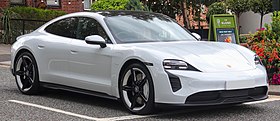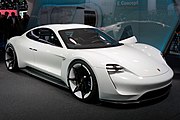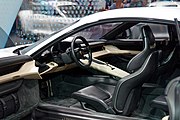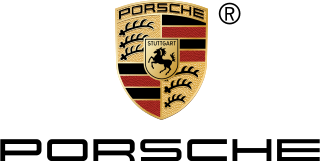
Dr. Ing. h.c. F. Porsche AG, usually shortened to Porsche, is a German automobile manufacturer specializing in luxury, high-performance sports cars, SUVs and sedans, headquartered in Stuttgart, Baden-Württemberg, Germany. The company is owned by Volkswagen AG, a controlling stake of which is owned by Porsche Automobil Holding SE. Porsche's current lineup includes the 718, 911, Panamera, Macan, Cayenne and Taycan.

The Porsche Cayenne is a series of automobiles manufactured by the German company Porsche since 2002. It is a luxury crossover SUV and has been described as both a full-sized and a mid-sized vehicle. The first generation was known internally within Porsche as the Type 9PA (955/957) or E1. It was the first V8-engined vehicle built by Porsche since 1995, when the Porsche 928 was discontinued. It is also Porsche's first off-road variant vehicle since its Super and Junior tractors of the 1950s, and the first Porsche with four doors. Since 2014, the Cayenne has been sold alongside a smaller Porsche SUV, the Macan.

The Porsche 930 is a turbocharged variant of the 911 model sports car manufactured by German automobile manufacturer Porsche between 1975 and 1989. It was the maker's top-of-the-range 911 model for its entire production duration and, at the time of its introduction, was the fastest production car available in Germany.

The Mitsubishi Eclipse is a sport compact car that was produced by Mitsubishi in four generations from 1989 until 2011. A convertible body style was added during the 1996 model year.

The Porsche 997 is the sixth generation of the Porsche 911 sports car manufactured and sold by the German automobile manufacturer Porsche between 2004 and 2013. Production of the Carrera and Carrera S coupés began in early 2004, all-wheel drive Carrera 4 and Carrera 4S began to be delivered to customers in November 2005, the Turbo and GT3 derivatives went on sale in late 2006 and the GT2 in 2007. In addition to the coupé and cabriolet versions, Targa versions of the Carrera 4 and Carrera 4S were also available, which carry on with the "glass canopy" roof design used since its first application on the 993 until the 991, which reverted to the classic targa top layout used on the early 911 Targas.
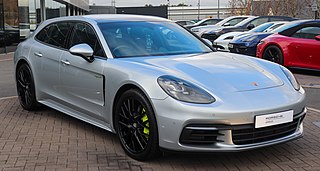
The Porsche Panamera is a mid to full-sized luxury car manufactured and marketed by German automobile manufacturer Porsche across three generations using a front-engine, rear or all-wheel drive configuration.

Ruf Automobile GmbH is a German car manufacturer. Formerly using Porsche bodies in white to build cars, today they build vehicles on their own bodies and chassis. They also manufacture performance parts for various Porsche models, including the 911, Boxster, and Cayman.
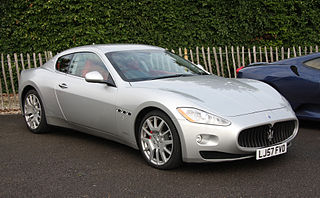
The Maserati GranTurismo and GranCabrio are a series of grand tourers produced by the Italian manufacturer Maserati, succeeding the Maserati Coupé and Spyder.

The Porsche 918 Spyder is a high performance sports car manufactured by German marque Porsche. The 918 Spyder is a plug-in hybrid powered by a mid-mounted naturally aspirated 4.6 L (4,593 cc) V8 engine, developing 447 kW at 8,700 RPM, with two electric motors delivering an additional 210 kW for a combined output of 652 kW (875 hp) and 1,280 N⋅m (944 lbf⋅ft) of torque. The 918 Spyder's 6.8 kWh lithium-ion battery pack delivers an all-electric range of 19 km (12 mi) under the US Environmental Protection Agency's five-cycle tests.

The Porsche Macan is a compact luxury crossover SUV (D-segment) produced by German manufacturer Porsche, a luxury car marque of Volkswagen Group, since February 2014. It is the smallest SUV from Porsche below the Cayenne.

The Porsche 991 is the seventh generation of the Porsche 911 sports car, which was unveiled at the 2011 Frankfurt Motor Show on 15 September as the replacement for the 997. The 991 was an entirely new platform, only the third since the original 911 launched in 1963. Production of the 991 generation ended on December 20, 2019, with 233,540 units produced.

The Porsche 981 is the internal designation given to the third-generation of the Boxster and second generation of the Cayman models built by German automobile manufacturer Porsche. It was announced on 13 March 2012 at the Geneva Auto Show with sales starting early summer 2012.

The Porsche 911 is a two-door 2+2 high performance rear-engined sports car introduced in September 1964 by Porsche AG of Stuttgart, Germany. It has a rear-mounted flat-six engine and originally a torsion bar suspension. The car has been continuously enhanced through the years but the basic concept has remained unchanged. The engines were air-cooled until the introduction of the 996 series in 1998.
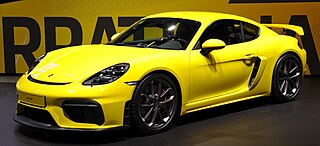
The Porsche 982 is the internal designation of the fourth generation Boxster/Cayman made by German automobile manufacturer Porsche. With the switch to a new turbocharged flat-four engine the marketing name for the models was changed to Porsche 718, in reference to the 718, which won the Targa Florio race in 1959 and 1960. The name is meant to evoke Porsche's past racing successes with light cars like the 718 that outmanoeuvred competitors with larger and more powerful engines.

The Porsche 992 is the eighth and current generation of the Porsche 911 sports car, which was introduced at the Porsche Experience Center, Los Angeles on 27 November 2018.

The Audi R8 is the second generation of the R8 sports car manufactured by German automobile manufacturer Audi. The Type 4S is based on the Lamborghini Huracán and shares its platform and engine. The Type 4S was introduced at the 2015 Geneva Motor Show and its production began in late 2015.

Porsche Unseen is a photo-book by Stefan Bogner and Jan Karl Baedeker about 15 unrevealed concept vehicles from the years 2005 to 2019 by German carmaker Porsche, a subsidiary of Volkswagen Group. Following the publish date on November 11, 2020, the concepts were shown online.
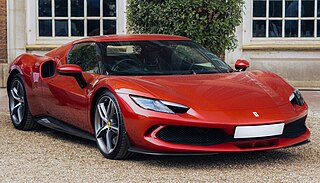
The Ferrari 296 is a sports car built since 2022 by the Italian company Ferrari. The 296 is a two-seater, offered as a GTB coupé, and a GTS folding hard-top convertible. It is a plug-in hybrid with a rear mid-engine, rear-wheel-drive layout and its power train combines a twin-turbocharged 120-degree block-angle V6 with an electric drive fitted in between the engine and gearbox. The 296 can be driven in electric-only mode for short distances, to comply with use in urban zero-emission zones.

The Porsche Mission R is a racing vehicle developed by Porsche equipped with a battery-electric drivetrain, first shown at IAA on September 6, 2021. Just as the Mission E previewed the Taycan sports saloon, the Mission R is a preview of a potential all-electric grand touring racing car for motorsport.
